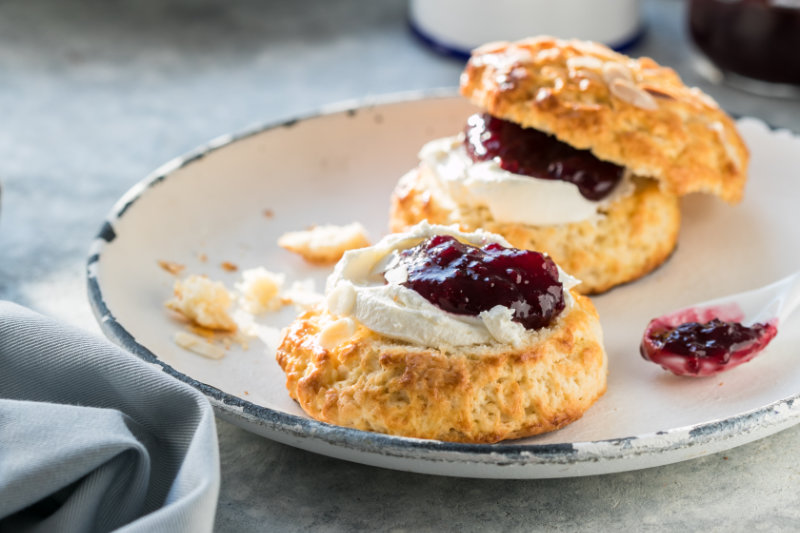Surely you have heard about the British tradition of afternoon tea. Scones are an essential part of this tradition, usually served with jam and cream with a peculiar texture and flavour, called Clotted Cream.
Scones are not exactly cakes, nor are they a cookie or bread that I’ve seen anywhere else. They are made with wheat flour, butter, sugar and milk. You will find the recipe below.
How did the name Scone come about?
After the fall of the Roman Empire, people from different tribes to what is today part of Germany, Belgium and Holland migrated to England, forming a new language called Anglo-Saxon.
The name Scone is believed to have originated from the German word “sconbrot”, which means fine or beautiful bread.
When the scone was created?
The first historical record of the word “Scone” was found in Scotland in 1513, through a poem by a local author.
According to the poem, the original recipe was made with oats, formed in a round shape and could be divided into 4 or 6 servings. The dough was roasted on a grill, over an open fire on the ground. Some say that scones emerged from Ireland but there is no concrete evidence.
When did the scone become famous?
Between 1662 and 1685, the then Queen Consort – Catarina de Bragança – introduced some customs from her homeland – Portugal – to the English Court. Among these customs were the consumption of tea and a small snack between lunch and dinner.
The afternoon tea was born. Adapted by the English Court to be an event where women from the high society could meet and socialise.
Later in 1840, the Duchess of Bradford – Anna Maria Russell – was invited by Queen Victoria to an afternoon tea at the palace. The Queen asked the Duchess to bring something light for their meal.
The Duchess took scones and the queen liked the novelty so much that she asked her cooks to make them in all the afternoon teas offered by the court.
How is the scone served?
In short, like a sandwich with jam and clotted cream. The order in which these fillings are added to the scone is a reason for debate.
In some places in the UK such as Cornwall, they cut the scone in half, add jam to the underside and add clotted cream on top. Other regions, such as Devon, do the exact opposite – clotted cream first and then jam.
I don’t think the order matters in this case but you will have to form your own opinion.
How is the texture of the scone?
Scones bought at supermarkets are denser, so it is recommended to heat them in an oven or microwave to make them softer and easier to cut.
In shops that serve afternoon teas, scones are freshly made and served warm.
British Scone recipe

A) Preparation time: 5 minutes
B) Cooking time: 15 minutes
C) Nutritional Information: 268 kcal per scone
This recipe yields 8 scones. It is possible to freeze and reuse it later.
D) Ingredients:
- 50g of unsalted butter
- 200g of self-rising wheat flour
- 1 tablespoon of refined white sugar
- 1 pinch of salt
- 125ml whole milk
E) Preparation instructions:
- Preheat the oven to between 200°C and 220°C
- Place baking paper on a baking tray
- Mix the butter with the flour, until the mixture resembles breadcrumbs
- Add the sugar and salt
- Make a hole in the center of the dough and add the milk. Stir until the dough becomes uniform
- Place the dough onto a floured surface and form a thick cylinder, about 3 to 4 cm thick
- Spread the uncooked scone onto the tray
- Finish it by brushing a little milk on top of the scone and let it bake in the oven.
- Bake them for approximately 15 minutes or until golden brown and cooked through
Let it cool for a few minutes. We recommend serving it warm with jam and cream, just as it is served in a traditional British afternoon tea.




